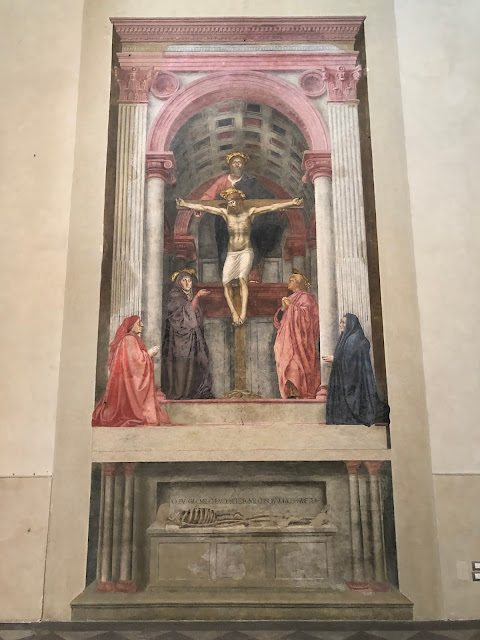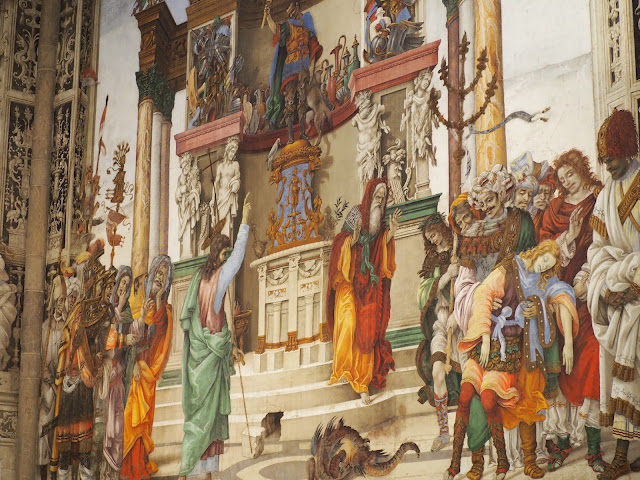【フィレンツェ】サンタ・マリア・ノヴェッラ教会 ジョット・マザッチョ・リッピ Firenze - Santa Maria Novella, Giotto, Masaccio, Lippi
教会のほぼ真ん中の天井から、ジョットの『十字架像』が吊り下げられている。
光のせいもあるのだろうが、その作品は実に美しく金色に輝いている。
ヴァザーリの『芸術家列伝』にも、この作品のことが書かれているが、ヴァザーリによれば弟子との共同制作であるようだ。
At the church of Santa Maria Novella, you can see the works of the masters of the early Renaissance.
Giotto's "Crucifix" is hung from the ceiling in the middle of the church.
Maybe it's because of the light, but the work is really beautiful and shining in gold.
Vasari's "Lives of the Most Excellent Painters" also mentions this work, but according to Vasari, it seems to be a collaboration with his disciples.
マザッチョの『聖三位一体』は、マザッチョの代表的な作品で、精密な遠近法が駆使された最初期の作品としても知られている。
マザッチョは、建築家のブルネレスキと交流があり、ブルネレスキの遠近法に関する知見に助けを借りて、この作品を描いたと言われている。
当時、この絵を見た人は、実際に壁の向こうに空間があるように感じたのかもしれない。
Masaccio's "Holy Trinity" is a representative work of Masaccio, and is also known as the earliest work that makes full use of precise perspective.
Masaccio is said to have interacted with architect Brunelleschi and painted this work with the help of his knowledge of Brunelleschi's perspective.
At that time, those who saw this painting may have felt that there was actually a space behind the wall.
教会の一番奥の中央祭壇のすぐ左隣に、コンディ家の礼拝堂があり、その奥には、ブルネレスキが制作した木造のキリスト像がある。
ブルネレスキは建築家として知られているが、友人で彫刻家のドナテッロを驚かせるためにこの像を作ったと言われている。
ドナテッロは、木造の彫刻があまり得意ではなく、この作品をみてブルネレスキに脱帽してしまったという。
ブルネレスキは、建築だけでなく、絵画や彫刻にも深く通じていた。まさに、万能人の一人でもあったのだろう。
Immediately to the left of the central altar at the back of the church is the Chapel of the Condi family, behind which is a wooden statue of Christ made by Brunelleschi.
Brunelleschi, known as an architect, is said to have created this statue to surprise his friend and sculptor Donatello.
Donatello is not very good at wooden carvings, and he said he had taken off his hat to Brunelleschi after seeing this work.
Brunelleschi was deeply familiar with painting and sculpture as well as architecture. He must have been one of the all-rounders.
中央の祭壇を挟んで右側に、ストロッツィ家の礼拝堂がある。そこには、フィリッピーノ・リッピの『聖ヨハネとピリポ伝』が描かれている。
On the right side of the central altar is the Strozzi chapel. It depicts Filippino Lippi's "St. John and the Apostle".
フィリッピーノ・リッピは、美しい聖母子像で知られるフィリッポ・リッピの子供で、父親と同じく画家として活躍した。
フィリッポ・リッピの有名な『聖母子と二人の天使』という作品には、幼い頃のフィリッピーノ・リッピの愛らしい姿が描かれている。
Filippino Lippi was a child of Filippo Lippi, known for his beautiful Madonna and Child, and was a painter as well as his father.
Filippo Lippi's famous work, Madonna and Child and Two Angels, depicts the lovely appearance of Filippo Lippi as a child.
フィリッピーノ・リッピは、父親が早く亡くなってしまったため、父親の弟子だったボッティチェリの元で絵を学んだ。
この『聖ヨハネとピリポ伝』をよく見ると、人物の表情などの表現に、確かにボッティチェリの影響が感じられる。
Filippino Lippi studied painting under Botticelli, his father's disciple, because his father died early.
If you look closely at this "St. John and Philip Den", you can certainly feel the influence of Botticelli on the expressions such as the facial expressions of the characters.
フィリッピーノ・リッピは、1487年にストロッツィ家からこの礼拝堂の注文を受けたが、別な注文のためにローマに行く必要があったため、1493年になってから制作を開始した。
そのローマでの仕事は、フィリッピーノ・リッピを代表する作品になった。さらに、ローマ滞在中にミラノのダ・ヴィンチに会いに行き、いくつかの助言を得たようだ。
Filippino Lippi received an order for the chapel from the Strozzi family in 1487, but began production in 1493 because he had to go to Rome for another order.
His work in Rome became a representative work of Filippino Lippi. In addition, he went to see Da Vinci in Milan during his stay in Rome and seems to have received some advice.
ローマからフィレンツェに戻って、この作品の制作は再開されたが、ローマでの経験がこの作品には反映されているに違いない。
Returning from Rome to Florence, the production of this work resumed, but the experience in Rome must be reflected in this work.









コメント
コメントを投稿